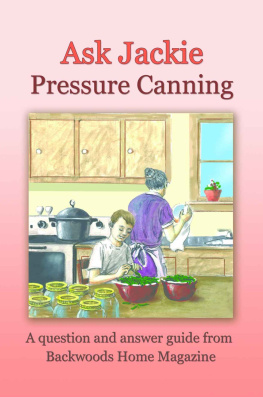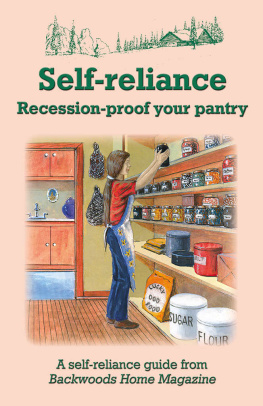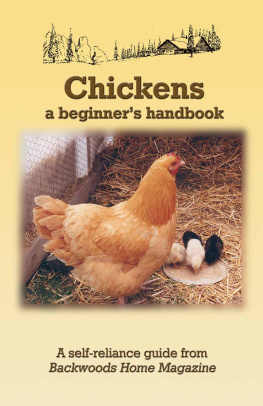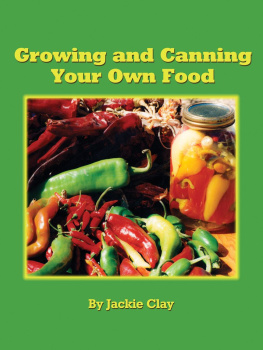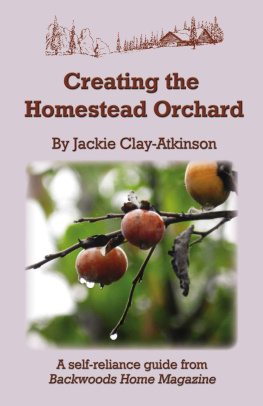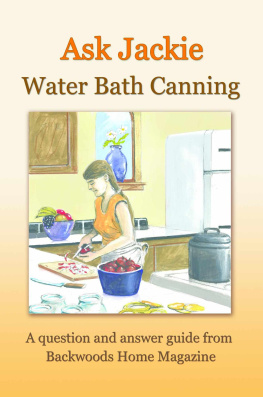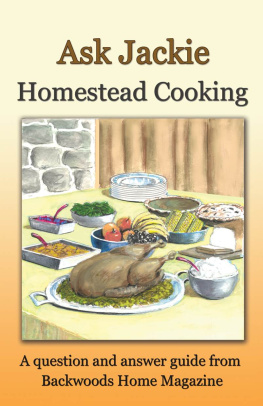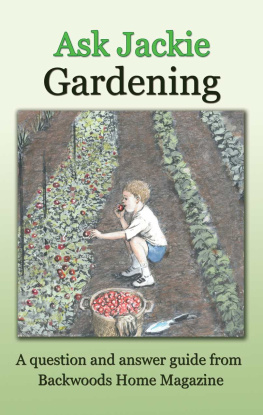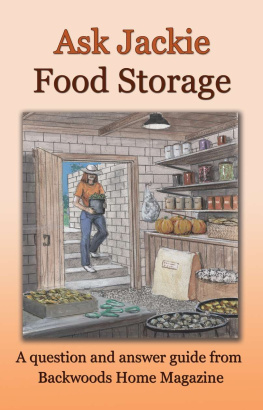Backwoods Home Magazine - Ask Jackie: Pressure Canning
Here you can read online Backwoods Home Magazine - Ask Jackie: Pressure Canning full text of the book (entire story) in english for free. Download pdf and epub, get meaning, cover and reviews about this ebook. year: 2012, publisher: Backwoods Home Magazine, genre: Home and family. Description of the work, (preface) as well as reviews are available. Best literature library LitArk.com created for fans of good reading and offers a wide selection of genres:
Romance novel
Science fiction
Adventure
Detective
Science
History
Home and family
Prose
Art
Politics
Computer
Non-fiction
Religion
Business
Children
Humor
Choose a favorite category and find really read worthwhile books. Enjoy immersion in the world of imagination, feel the emotions of the characters or learn something new for yourself, make an fascinating discovery.
- Book:Ask Jackie: Pressure Canning
- Author:
- Publisher:Backwoods Home Magazine
- Genre:
- Year:2012
- Rating:5 / 5
- Favourites:Add to favourites
- Your mark:
- 100
- 1
- 2
- 3
- 4
- 5
Ask Jackie: Pressure Canning: summary, description and annotation
We offer to read an annotation, description, summary or preface (depends on what the author of the book "Ask Jackie: Pressure Canning" wrote himself). If you haven't found the necessary information about the book — write in the comments, we will try to find it.
Ask Jackie: Pressure Canning — read online for free the complete book (whole text) full work
Below is the text of the book, divided by pages. System saving the place of the last page read, allows you to conveniently read the book "Ask Jackie: Pressure Canning" online for free, without having to search again every time where you left off. Put a bookmark, and you can go to the page where you finished reading at any time.
Font size:
Interval:
Bookmark:
Table of Contents
Ask Jackie
Pressure Canning
Copyright 1999-2012
ISBN: 978-0-9860152-6-7
Backwoods Home Magazine
PO Box 712
Gold Beach, Oregon 97444
www.backwoodshome.com

Edited by Jessie Denning, Julia Denning, Haley Kessel, Connie Sayler, Lisa Nourse, Rhoda Denning, and Ilene Duffy
Cover art by Don Childers
Illustrations by Don Childers, Jessie Denning, and John Dean
Introduction
Pressure canning is a terrifically important homesteading skill that more and more folks are rediscovering lately. By learning how safe and easy it is to pressure can, you will open a vast array of foods to add to your pantry shelves. In any one year, I usually can ham chunks and dices, roast beef slices and dices, stewing beef, stewing venison, venison steaks and roasts, chicken breast, chicken dices, chicken chunks, three flavors of meatballs, two flavors of spaghetti sauce with meat, turkey breast slices, turkey chunks, beef broth, chicken broth, turkey broth, soups, stews, pepperoni, pizza sauce, green beans, peas, baked beans, pintos for refried beans, kidney and other dry beans, sweet corn, creamed corn, corn with peas, corn with carrots, corn with mixed vegetables, cabbage, rutabagas, potatoes, carrot slices, carrot chunks, whole carrots, squash chunks (I pure them and make pumpkin pie!), and a whole lot more. All using a pressure canner!
As pressure canning looks more involved than water bath canning, and because some folks have heard horror stories passed down through the generations about pressure canners blowing up, a lot of people are fearful to even try pressure canning. Im here to tell you that modern pressure canners are safe and easy to use. Just follow directions and stay in the same room as your canner to monitor the pressure. No sweat. Youll be so glad you gave it a whirl!
A pressure canner is necessary for canning all low-acid foods like vegetables, meats, and combinations of the two. A boiling water bath canner never gets hot enough to kill dangerous bacteria and toxins that could possibly find their way into your low-acid foods. You must use a pressure canner and proper processing times to be safe.
Most of the information in this book pertains to pressure canning, but there could be a couple questions about water bath canning as well.
In these pages, I answer questions about such things as canning meat, dairy products, meals in a jar, vegetables, tomatoes, nuts, peppers, and a whole lot more. Have fun reading and I hope I answered a lot of your own questions along the way.
Jackie Clay
Dairy

Canning powdered milk
I have a question concerning canning milk. I bought milk at a good price and also powdered milk. I thought I could make up a gallon of powdered milk and combine it with a half-gallon of 2% milk and can it up in order to stretch my stores. Well, after about three months it spoiled. I used both the pressure canner and water bath. The pressure canned came out somewhat darker in color than the water bath but it all appeared okay. I put it away for a time then checked them and the milk turned almost solid in the jar, but could in some cases be jiggled back to liquid.
What did I do wrong? Was there something in the powdered milk that caused it to sour? And boy, what a smell.
Pat Fessler, Maryland
I honestly dont know what happened! Ive never had canned milk go sour. But Ive never canned any powdered milk either. (That shouldnt have had any problems.) Pressure canned milk always does get a little darker, due to the sugars in the milk getting heated to high temperatures. And it is common for it to get thicker, like condensed milk. But it shouldnt go bad!
Pressure canning milk
We will be getting a milk cow soon and are excited to use the milk for butter, cheese, etc. I would also like to can some. But I just cant find out how long to process it. Because of the acidity, I believe the only way to successfully can it would be in a pressure canner. Could you please help me?
Dianna
Milk is easy to can, but it does not come out like raw milk. It is fine to cook with, but it sort of caramelizes and gets thicker. Milk is higher in acid than one might think, containing lactic acid. So you can either pressure can it or process it in a water bath canner.
To pressure can the milk, cool your fresh, strained milk, then pour it into clean jars. Leave half an inch of room at the top of the jar. Place a hot, previously boiled lid on the jar and screw down the ring firmly tight. Process in a pressure canner for 10 minutes, at 10 pounds pressure (unless you live at an altitude requiring adjustment; see your canning manual for directions).
To water bath process your milk, simply place the jars in your hot water bath canner and process for 60 minutes, counting from the time the kettle comes to a rolling boil.
Canning milk
I have recently been trying to can milk. According to a recipe online, you can do it. This recipe has you place your milk in clean quart jars in pressure canner. Add 2-3 inches of water and get pressure to the 5 lb. mark. Then cut off heat and let steam escape. Viol, you canned milk! Well, so far, so good, until I went back to check on it a few weeks later. To my surprise, I have lots of yogurt. I kept it out of light, even storing some under the house. Temps only got from 65-80F after cooling in house and under. My questions are these: 1)Can you successfully can milk? 2)How can you do it without getting yogurt and/or sick? I am using raw cows milk.
Melisa Mink, Mississippi
Yes, you can home can milk. But not at 5 pounds pressure. Nor do you cut off heat and let steam escape. Heres how I do it.
Remember that canned milk does not look or taste like fresh milk. It is a bit thicker and a little more tan in color. But it is great for cooking.
You can use the boiling water bath method by filling hot, sterilized jars with warm, strained milk. Leave inch of headspace. Wipe the rim of the jar clean, place a hot, previously simmered lid on the jar, and screw the ring down firmly tight. Process quarts in a boiling water bath canner for 60 minutes.
Or you can pressure can it by filling the jars with warm, strained milk, leaving inch of headspace. Wipe the rim of the jar clean, place a hot, previously simmered lid on the jar and screw the ring down firmly tight. Process quarts for 10 minutes at 10 pounds pressure in a pressure canner.
If you live at an altitude above 1,000 feet, consult your canning book for instructions on increasing your time if you water bath, or pressure if you are using a pressure canner.
Canning whole milk
I tried canning whole milk, about 10 quarts. They have all thickened up and the jars have sealed. Can I use this milk in some way? I lucked out at the time I thought, as our local grocers ad had four gallons for $9.
Rosemary Barber, Iowa
You can use this milk in any recipes calling for milk, such as gravies, white sauces, baking, casseroles, noodle dishes, and more. I use it in place of evaporated milk, as it is thicker than regular milk.
Canning dry milk?
I just read in BHM Issue #94 your description of how to can fresh milk. Do you know if its possible to can reconstituted non-fat dry milk? I have tons of it.
Pat Crowder, Colorado
I wouldnt bother reconstituting dry milk in order to can it. Canned milk is not really that good, except in cooking. The dry milk lasts a long time in airtight jars or even in the original boxes and doesnt take up canning jars better used for something else. Nor do they take up much room on a pantry shelf. Maybe you need to begin using the oldest milk, in order to rotate your stock. Use it in puddings, cream pies, ice milk, and custards. You can even make cheeses out of it if you want.
Next pageFont size:
Interval:
Bookmark:
Similar books «Ask Jackie: Pressure Canning»
Look at similar books to Ask Jackie: Pressure Canning. We have selected literature similar in name and meaning in the hope of providing readers with more options to find new, interesting, not yet read works.
Discussion, reviews of the book Ask Jackie: Pressure Canning and just readers' own opinions. Leave your comments, write what you think about the work, its meaning or the main characters. Specify what exactly you liked and what you didn't like, and why you think so.

